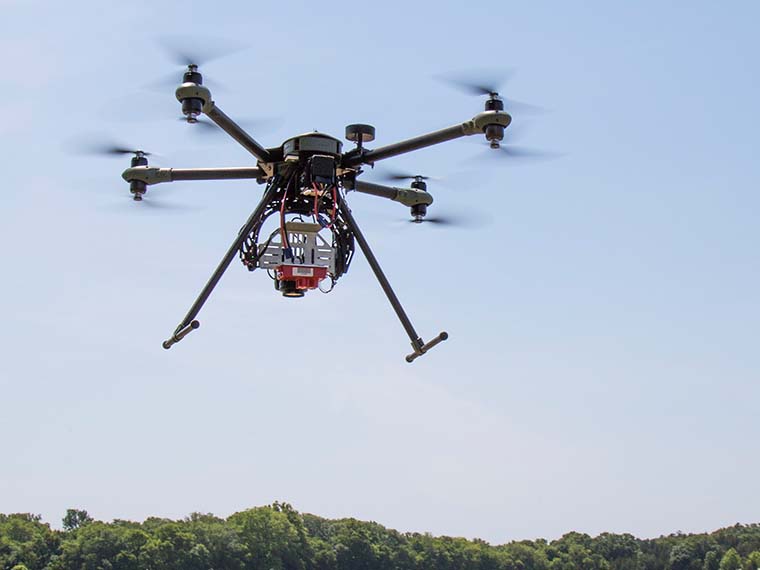The information presented on this page may be dated. It may refer to situations which have changed or people who are no longer affiliated with the university. It is archived as part of Mississippi State University's history.
IN THE AGE OF BIG DATA, an endless amount of information is collected and analyzed to reveal patterns, trends, and associations for a myriad of products and purposes across an abundance of industries. One place big data has cropped up the most has been in America's ag fields. While data collection of inputs, yield, and field conditions are now part of a producer's daily life, how can that data translate to decisions at the square-foot level? Drs. Xiaofei Li and Mark McConnell, both scientists in the Mississippi Agricultural and Forestry Experiment Station, are partnering to find ways to leverage that data to maximize both producer profitability and environmental stewardship.
"Farmers accumulate a lot of data from their production practices and many of them are struggling to convert that data into decision making. There has been plenty of investment in collecting data and farmers are looking for value in that data," said Li, who is an assistant professor in the Department of Agricultural Economics in the College of Agriculture and Life Sciences.
Li is developing a tool to determine which areas of the field are profitable and which are not. In a recent case study on a farm in the Mississippi Delta, he conducted a whole farm analysis of profitability mapping. The team created profitability maps from yield data of 21 fields across four years. Researchers then identified unprofitable areas within the fields and estimated average annual loss caused by those unprofitable areas. Li determined that at the whole farm level, even if excluding the fixed costs (such as equipment ownership, land rents, loan interests, and overhead costs), approximately four percent of the fields were deemed unprofitable, totaling an annual estimated profit loss at $6,896 or 1.6 percent of total farm profit.
Li noted the study's limitations. "Spatial input data was unavailable or incomplete, and we had to use Mississippi planting budget data as opposed to actual profits," he said.
Despite those limitations, he said the study represents a pilot effort in developing a data-driven tool for farmers.
"This study illustrates how to utilize profitability mapping to make precision farming decisions, and quantifies the amount of profit improvement based on real-world farm production data," Li said.
While Li has been finding methods to help farmers estimate which parts of the field are least profitable, McConnell, an assistant professor in the Department of Wildlife, Fisheries and Aquaculture in the College of Forest Resources, is focused on finding ways to make conservation practices profitable for farmers. McConnell, along with Dr. Wes Burger, MAFES associate director, has developed the Mississippi State University Precision Conservation Tool, aimed at finding the conservation practices most economically beneficial to producers.
McConnell explained how the software works. "Higher yield doesn't necessarily mean more profit if the inputs are higher for those acres. That's why we focus on creating profit maps to identity unprofitable or marginally profitable regions of the field that we then match with conservation programs and practices through the USDA that pay farmers to take land out of production. After that, we evaluate if the payment of the conservation program is actually more profitable than what that part of the field would make if left in production," he said.
McConnell calls the concept targeted conservation, which means only enrolling in conservation when it's more profitable for the producer.
"The number one driver in a producer's decision-making process is economic profitability. Farmers are already operating on slim margins and we don't want to add to their plate. We want them to see conservation as an economic opportunity," he said.
As far as how much profitability the right conservation program can garner, McConnell noted that in one recent study in Lowndes County, Mississippi, the range was vast.
"We saw an increase from one percent all the way to 250 percent. While I'd never ask a farmer to make a change for a one percent increase, a 250 percent increase is substantial," he said.
McConnell and Li are co-advising two wildlife, fisheries and aquaculture master's students-each focused on different aspects of precision conservation. Emily Bedwell is analyzing long-term yield data to determine the breakeven commodity prices required to make profitable conservation decisions while Makayla Brister is trying to estimate the profitability of different conservation practices across the Black Belt Prairie and Mississippi Delta. Brister's initial efforts include overlaying profitability data over the biologist ranking index for bobwhite habitat to identify targeted conservation opportunities across the bobwhite range in Mississippi and beyond.
McConnell said no matter what, his goal is to develop research tools that change the way farmers approach conservation.
"Historically, farmers see conservation as a money loser. The idea of not farming something to make money is very novel to them. We want them to view conservation as an economic opportunity, instead of a hindrance," he said. "Through targeted conservation, we reduce risk, increase stability, and diversify that whole farm portfolio so they can spend that money and effort elsewhere and not make those risky decisions."
Li echoes the sentiment and emphasized producers partnering with researchers is essential to move the technology forward.
"I want to encourage farmers to work with researchers. We can develop analytic tools, but we need the opportunity to apply and improve those tools. Producers can help since they know much more about their field than we do, and they, in turn, benefit more from these tools when they are properly developed," Li said.
This research was funded by the Mississippi Agricultural and Forestry Experiment Station.

